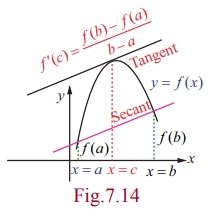Mean Value Theorem | Mathematics - LagrangeŌĆÖs Mean Value Theorem | 12th Maths : UNIT 7 : Applications of Differential Calculus
Chapter: 12th Maths : UNIT 7 : Applications of Differential Calculus
LagrangeŌĆÖs Mean Value Theorem
LagrangeŌĆÖs Mean
Value Theorem
Theorem 7.3
Let f (x) be continuous in a closed interval [a, b] and differentiable in the open interval (a , b) (where f (a), f (b) are not necessarily equal). Then there exist at least one point c Ōłł( a , b) such that,
f ŌĆ▓(c) = f (b) ŌłÆ f (a) / b ŌłÆ a ... (6)

Remark
If f (a) = f (b)
then LagrangeŌĆÖs Mean Value Theorem gives the RolleŌĆÖs theorem. It is also known
as rotated
RolleŌĆÖs Theorem.
Remark
A
physical meaning of the above theorem is the number f (b) ŌłÆ f (a) / b ŌłÆ a =  can
be thought of as the average rate of
change in f ( x) over (a, b) and f (c) as an instantaneous
change.
can
be thought of as the average rate of
change in f ( x) over (a, b) and f (c) as an instantaneous
change.
A
geometrical meaning of the LagrangeŌĆÖs mean value theorem is that the
instantaneous rate of change at some interior point is equal to the average
rate of change over the entire interval. This is illustrated as follows :
If a car
accelerating from zero takes just 8 seconds to travel 200 m, its average
velocity for the 8 second interval is 200/8 = 25 m/s. The Mean Value Theorem says
that at some point during the travel the speedometer must read exactly 90 km/h
which is equal to 25 m/s.
Theorem 7.4
If f ( x) is continuous in closed interval [a , b]
and differentiable in open interval (a
, b) and if f ŌĆ▓( x) > 0, ŌłĆx Ōłł (a, b) , then for, x1 ,
x2 Ōłł[a , b]
, such that x1 < x2 we have, f (x1 ) < f (x2 ) .
Proof
By the
mean value theorem, there exists a c Ōłł ( x1 , x2
) ŌŖé (a, b) such that,
f (x2 ) ŌłÆ f (x1)
/
x2 ŌłÆ x1 = f ŌĆ▓(c)
Since f ŌĆ▓(c)
>
0 , and x2 ŌłÆ
x1 >
0 we have fŌĆē(x2) ŌĆō fŌĆē(x1) > 0.
We
conclude that, whenever x1
<
x2 , we have f (x1
) <
f (x2 ) .
Remark
If f ŌĆ▓( x) < 0, ŌłĆx Ōłł (a, b) , then for, x1 , x2 Ōłł [a,
b] , such that x1 < x2
we have, f (x1 ) > f
(x2 ) .
The
proof is similar.
Example 7.25
Find the
values in the interval (1,2) of the mean value theorem satisfied by the
function f (x) = ŌłÆ x - x2 for 1 Ōēż x Ōēż 2.
Solution
f (1) = 0 and f (2) = ŌłÆ2
. Clearly f ( x) is defined and
differentiable in 1 < x < 2 . Therefore, by the Mean Value Theorem, there exists a c Ōłł(1, 2) such that

f ŌĆ▓(c) = f (2) ŌłÆ f (1) / 2 ŌłÆ1 = 1ŌłÆ 2c
That is,
1ŌłÆ 2c = ŌłÆ2 ŌćÆ c = 3/2
.
Geometrical meaning
Geometrically,
the mean value theorem says the secant to the curve y = f (
x) between x = a and x = b is parallel to a tangent line of the curve, at some point c Ōłł(a,
b) .

Consequences of LagrangeŌĆÖs Mean Value Theorem
There
are three important consequences of MVT for derivatives.
(1) To
determine the monotonicity of the given function (Theorem 7.4)
(2) If f ŌĆ▓(x)
=
0 for all x in (a, b) , then f is constant on (a, b) .
(3) If f ŌĆ▓( x) = gŌĆ▓(
x) for all x , then f ( x) = g(
x) + C
for some constant C .
Related Topics